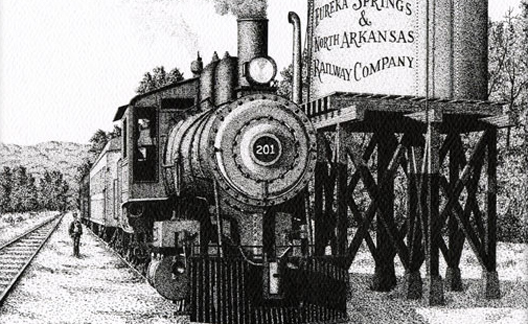Railroads
by Joshua Heston
The coming of the rails was instrumental in developing the Ozark region just as it was across the great American West.
What is notable is this development occured much later in our nation's history than elsewhere.
Harold Bell Wright lamented the recent coming of the rail in the comparatively late date of 1907.
As interstate travel was to do much later in the 20th century, the railroads proved a double-edged sword to the Ozark region.
The coming of “careless idlers” may well have threatened traditional Ozarkian culture and certainly changed it.
However, the introduction of the rail was instrumental in developing a tourist culture so obsessed with the Ozark heritage that it has been popularized and maintained to this day.
Despite the decline of the railroads, this is indeed a story “still in the telling.”
From Harold Bell Wright:
“The old shepherd answered softly, ‘One did.’ Then rising to his feet and pointing to Roark valley, he said, ‘Before many years, a railroad will find its way yonder. Then many will come, and the beautiful hills that have been my strength and peace will become the haunt of careless idlers, and a place of revelry.
‘I am glad I shall not be here.’”
— page 260, Wright, Harold Bell, The Shepherd of the Hills, The Shepherd of the Hills Historical Society, Inc., 1907.
Continued above right...
plate 1. Artwork detail, Eureka Springs & North Arkansas Railway Company. Artist: Joe Benjamin.
Memories from Richard Ryan:
When I was a kid — back in the 1940s — we didn’t have an automobile. We lived three miles from a small village named Irwin, Missouri (in Barton County six miles north of Lamar).
Once a week or so we would hitch the horses up to the farm wagon and go to Irwin to trade at the small country store located there. Dad had a few head of milk cows and my folks always had a flock of laying hens. We took milk and eggs with us which the owners of the store would buy. I still remember the pot-bellied stove located in the center of the store and the cozy smell of the meats and candies for sale.
The Missouri Pacific railroad ran through Irwin and there was even a train station. I was always fascinated — and somewhat frightened — by the big steamer and its steam whistle. On a clear still night you could hear that lonesome whistle blow three miles away at home. To this day I have a huge love for the old steamers. There is a lot to be said for those good old days.
About the only time I get a little depressed is when I drive out by the area where I was raised and spent so many good times. Everyone and most everything associated with those times are gone.
Sadly, it is true. You can’t go home.
— Richard Ryan
From Phyllis Rossiter:
“The railroads, particularly the Frisco, played a role in opening this land [the US 60 area east of Springfield] to settlement.
“The railroad owners had acquired large federal land grants and were anxious to attract settlers. They sent executives directly to Germany as recruiters in an effort to dispose of the land to promote growth...”




